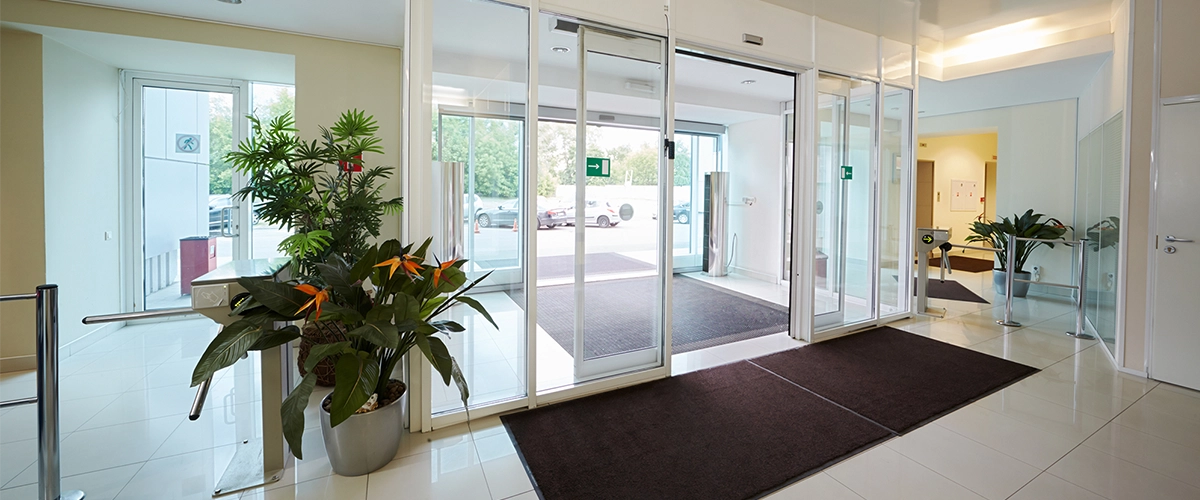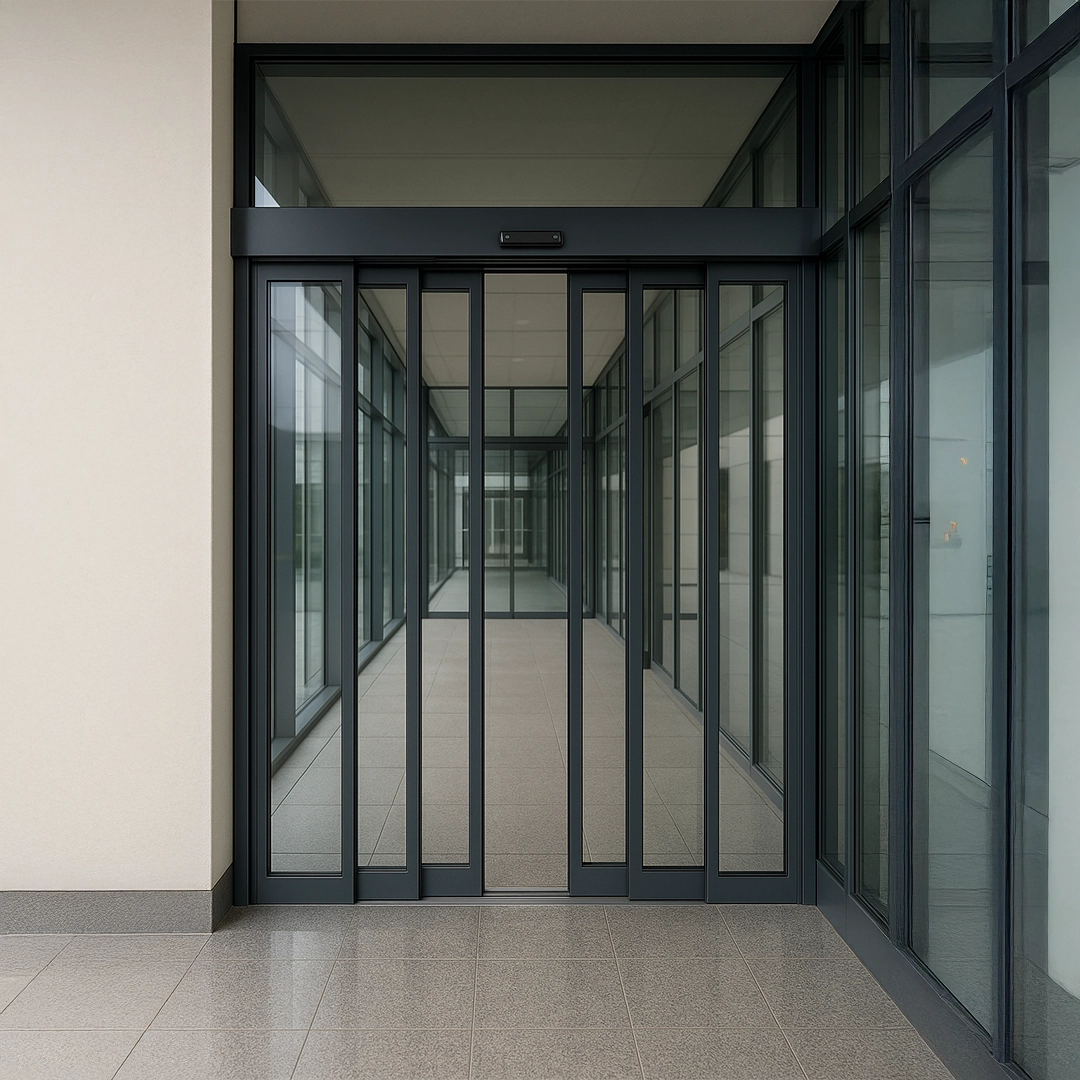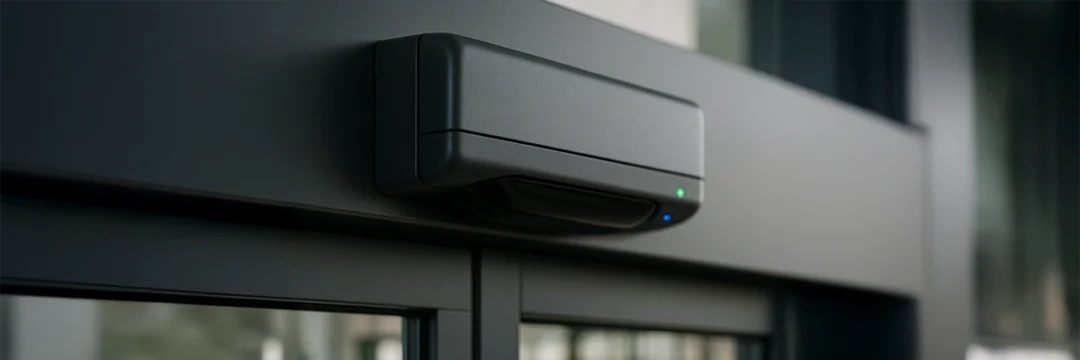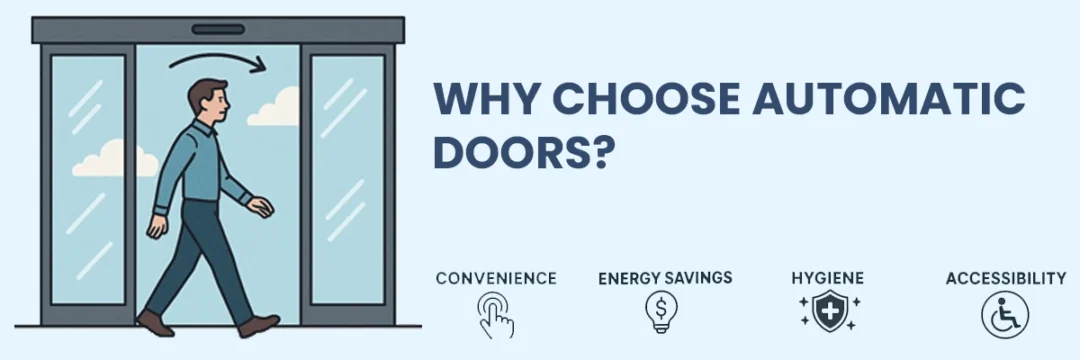How do Automatic Doors work?
In this article, we’ll explore the inner workings of automatic doors, the types of sensors they use, and the key components that make them reliable and user-friendly in a wide range of environments.

Automatic doors are a familiar feature in shops, offices, hospitals, and public buildings, welcoming visitors with a seamless, hands-free experience. But while they may seem simple on the surface, there’s a complex system of sensors, motors, and control units working behind the scenes to open and close them at precisely the right moment.

Using our years of experience and knowledge building, we’re going to pass on the inner workings of automatic doors in this article, and how they can benefit your specific environment.
In This Article
1. What Are Automatic Doors?
Automatic doors are entrance systems that open and close without the need for manual operation. Using automatic door sensors and motorised mechanisms, and automatic door hardware, these doors detect movement or presence and respond accordingly – making access quicker, easier, and more hygenic.
There are several types of automatic doors, each suited to different environments and requirements.
Automatic Sliding Doors
Automatic Sliding Doors are one of the most widely used types in commercial settings. They consist of one or more panels that move horizontally along a track, either opening from the centre (bi-parting) or sliding to one side (single-sliding).
Key Features
- Smooth and silent operation
- Space efficient – no door swing required
- Available with single or double leaf configurations
- Can integrate with access control systems and emergency break-out functions
Common Environments
- Supermarkets and retail outlets
- Airports and transport terminals
- Healthcare facilities and pharmacies
- Office building entrances

Ensuring your automatic door regulations compliance
AUTOMATIC DOOR SERVICING
Mechanical doors, like any piece of moving mechanical equipment falls under the 2008 Machinery Directive. This basically states that the machine (in this case, the automatic door) should be routinely maintained on an on-going frequent basis. So, to ensure you’re staying compliant, make sure to book in your annual service. If you’re situated in a busy environment, think about making it every 6 months instead of 12.

Automatic Swing Doors
Key Features
These doors operate on a pivoting hinge, just like a traditional manual door, but are powered by an automatic operator mounted above or beside the door. They can swing inwards or outwards depending on the configuration.
- Excellent for retrofitting existing manual doors
- Available as single or double swing options
- DDA-compliant for accessibility
- Can be push-button, sensor-activated, or access-controlled
Common Environments
- Care homes and assisted living facilities
- Hospitals and GP surgeries
- Office buildings and schools
- Entrances with restricted lateral space

Telescopic Sliding Doors
Telescopic doors are a variation of sliding doors, but with multiple narrower door leaves that slide and stack in sequence to one or both sides of the opening. This design allows for a much wider opening than standard sliding doors without requiring additional overall width.
Key Features
- Maximises usable opening width in tight spaces
- Suitable for wide-span entrances with limited wall space
- Creates a visually impressive entrance
- Available in single or bi-parting formats
Common Environments
- Hotels and hospitality venues
- Train stations and transport hubs
- Exhibition centres and event spaces
- Premium commercial and retail spaces

Automatic Revolving Doors
Revolving doors consist of three or four leaves that rotate around a central axis within a cylindrical enclosure. Unlike other automatic doors that open entirely, revolving doors create a continuous barrier between the indoor and outdoor environment while still allowing smooth entry and exit.
Key Features
- Minimises energy loss by controlling airflow
- Ideal for high foot traffic areas
- Enhances building security and access control
- Can be manually or automatically driven
Common Environments
- Corporate headquarters and office lobbies
- Hotels and conference centres
- Museums, airports, and government buildings

2. Automatic Door Hardware
Automatic doors may look simple in operation, but behind every seamless opening and closing motion lies a well-engineered system made up of several core components. Each part plays a crucial role in ensuring the door operates reliably, safely, and efficiently.

Automatic Door Sensors
Sensors are the “eyes” of any automatic door system. They detect motion or presence and signal the door to open when someone approaches or moves within a defined range. Think of a supermarket entrance – as you approach, the motion sensor above detects your presence and opens the door. If you pause or a trolley blocks the path, the safety sensor ensures the doors remain open until the way Is clear.
Motion Sensor / Activation & Presence Sensors
Modern automatic door systems typically utilise motion and presence sensors that operate using infrared, microwave, or a combination of both technologies to detect individuals approaching or standing in front of the door. Contemporary sensors are generally dual-technology, incorporating both infrared and microwave detection to meet the requirements of BS7036 and EN16005 standards.
These advanced sensors are equipped with a self-monitoring safety system that interprets any failure within the detection field as the presence of a person, ensuring the door remains safely open. This monitoring process occurs each time the door operates or at regular intervals—typically every 30 seconds—when the door is in standby mode.
Older systems, by contrast, often rely on activation-only sensors and use photocells integrated into the frame for basic safety detection. These legacy systems generally lack certified monitoring capabilities. For both safety and compliance reasons, it is strongly recommended that outdated sensors be upgraded to modern, fully monitored systems.
- Infrared sensors detect changes in heat (body temperature).
- Microwave sensors emit and receive radio waves, detecting movement through Doppler shifts.
Safety Sensors
Safety sensors ensure the door doesn’t close on someone or something in the doorway.
- Presence sensors continuously scan the threshold to detect people or objects.
- Safety beams (light curtains or infrared beams) create an invisible line – if interrupted, the door won’t close.
Automatic Door Control Unit
At the heart of every automatic door system is the control unit – an internal circuit board located within the operator housing. This component interprets signals from the sensors and activates the motor accordingly. It also manages safety features, timing settings, and operating logic.
In addition to the internal controller, many systems include a wall-mounted control panel or key switch. These allow building staff to manually set the door mode (e.g., automatic, locked, hold open) or make quick adjustments without accessing the internal electronics.
Key Features
- Processes sensor signals to trigger door movement
- Controls door opening/closing speed and timing
- Manages safety systems and access control integration
- Can be programmed to respond to time schedules or security settings
Automatic Door Operator Motor & Gearbox
The motor is responsible for physically moving the door, while the gearbox ensures the motion is smooth and appropriately powered for the door’s weight and type. In the event of an emergency, the motor is designed to allow manual operation and can also work in tandem with battery backups.
Sliding Doors
- The motor pulls the door panels along a track via a belt or gear system, ensuring a quiet and fluid motion.
Swing Doors
- The motor operates a pivoting arm or linkage that pushes or pulls the door open and closed.
Automatic Door Power Supply
Automatic doors require a constant electrical power source to operate. Most systems are hardwired into the building’s main supply. A reliable power source is essential for continuous, safe operation – especially in high-traffic or critical areas like hospitals.
Power Features
- Standard Power Supply: Usually 230V AC with a transformer reducing to a safe operating voltage.
- Battery Backup: Some doors feature emergency battery packs to allow limited operation during power outages.
- Energy Efficiency: Newer systems are designed to consume minimal power and may include standby modes when not in use.
Automate Your Existing Swing Door
DID YOU KNOW?
You can upgrade your existing swing door and turn it automatic? Book a consultation with our expert team today. We’ll discuss your needs, evaluate your current door setup, and provide personalised recommendations on how to integrate automation seamlessly. Whether it’s through a site survey or a detailed consultation, we’re committed to helping you find the best solution to enhance accessibility and efficiency in your space.

3. How The System Works - Step-by-Step

Although automatic doors may seem simple from the outside, they follow a carefully programmed sequence of actions involving several components working in unison. Below is a step-by-step breakdown of what happens every time someone walks up to an automatic door.
Person Approaches the Door
As someone walks towards the entrance, they enter the detection zone of the automatic door system. This zone is carefully calibrated to detect approaching individuals at the right distance – far enough for a smooth entry, but not so far that the door opens unnecessarily.
Sensor Detects Motion or Presence
Sensors – typically mounted above the door or built into the header – detect movement or the presence of a person. At this stage, the system recognises that an action is needed and triggers the next part of the sequence.
- Motion sensors (infrared or microwave) pick up on movement.
- Presence sensors ensure the person remains in the path before initiating closure.
Signal Sent to the Control Unit
Once the sensor has detected movement or presence, it sends a signal to the control unit – the electronic circuit board located within the door operator.
The control unit interprets this signal and decides what to do based on its programmed logic.
It checks:
- Is the door currently open or closed?
- Are there any obstructions?
- What mode is the door in (automatic, hold-open, access control)?
Only if all safety and operational conditions are met will the door proceed to open.
Motor Activates the Opening Mechanism
The control unit sends a command to the motor to begin the door’s movement. This mechanism varies by door type:
- For sliding doors, the motor drives a belt or gear system that pulls the door leaf along a track.
- For swing doors, the motor operates a rotating arm or linkage that pushes or pulls the door open.
- For telescopic doors, the system coordinates multiple panels to slide and stack neatly in a compact space
Modern motors are designed to be quiet, energy-efficient, and adjustable to suit the door’s weight and desired opening speed.
Safety Sensors Ensure the Path is Clear
As the door opens or prepares to close, safety sensors come into play to prevent accidents.
- Presence detectors scan the threshold to ensure no one is standing in the way.
- Safety beams act as invisible tripwires across the opening; if broken, they send a signal to stop or reopen the door.
These sensors are crucial in preventing the door from closing on people, wheelchairs, trolleys, or other obstacles.
Door Closes After a Preset Timeout
Once the system detects that the path is clear and no additional motion is present, the control unit initiates a timer (typically adjustable between 2-10 seconds), depending on the site’s needs. After this timeout:
- The motor reverses to close the door gently.
- If any motion or obstruction is detected during closing, the door will either pause or reopen, depending on how the system is configured.
This closing cycle ensures energy efficiency (by minimising heat loss), maintains security (by not leaving the door open too long), and balances accessibility for slower-moving individuals.

4. Benefits of Automatic Doors
Automatic doors offer more than just convenience – they provide measurable improvements in accessibility, hygiene, security, and energy performance. Whether installed at a retail entrance, office block, healthcare facility, or transport hub, they enhance the user experience while contributing to operational efficiency and compliance with legal standards.
Accessibility - DDA Compliance and Inclusive Design
One of the most important benefits of automatic doors is improved accessibility. In line with the Equality Act 2010 and DDA (Disability Discrimination Act) requirements, business and public buildings are expected to provide easy access for all users, including wheelchair users, the elderly, and those with mobility impairments.
How automatic doors help:
- Remove the need for physical strength to open heavy doors
- Can be activated via sensors, push buttons, or access cards
- Allow safe and dignified access to everyone, without assistance
At Next Doors Ltd, we often work with care homes, hospitals, and educational facilities to retrofit existing entrances with automatic solutions that meet accessibility standards and improve inclusivity.
Hygiene - Touch-Free Operation
Since the pandemic, the demand for contactless entry has increased dramatically. Automatic doors help minimise the spread of germs and bacteria by removing the need to touch handles or push plates.
Ideal for environments where hygiene is critical:
- Hospitals and GP surgeries
- Food service businesses and clean rooms
- Public toilets and transport hubs
By using motion sensors or infrared presence detectors, these doors operate completely hands-free, improving hygiene and giving peace of mind to staff, customers, and visitors.
Security - Integration with Access Control Systems
Modern automatic door systems can be seamlessly integrated with access control, such as keypads, fob readers, swipe cards, or facial recognition systems. This allows for controlled entry to staff-only areas, secure environments, or after-hours entrances.
Security benefits include:
- Restricting access to authorised personnel
- Monitoring entry and exit with audit trails
- Locking doors automatically outside working hours
For commercial properties, schools, and public buildings, this feature adds a valuable layer of security while maintaining ease of entry during designated times.
Energy Efficiency - Reducing Heat Loss & Running Costs
Automatic doors open only when needed and close promptly after use, significantly reducing the loss of heated or cooled air from a building. When paired with efficient sensors and programmable control units, they contribute to better insulation and lower energy bills.
Why this matters:
- Helps maintain internal climate control
- Reduces HVAC workload and energy consumption
- Supports sustainability goals and green building certifications
Many of our clients in retail, hospitality, and transport choose sliding or revolving automatic doors specifically for their energy-saving properties, especially in high-traffic areas where traditional doors would remain open too long.

5. Maintenance & Servicing
While automatic doors are engineered for reliability and ease of use, they are still mechanical and electronic systems, meaning they require regular care to keep them functioning at their best. Proper maintenance not only extends the lifespan of the equipment but also ensures the safety, compliance, and smooth operation of the entire entrance system.
Why Regular Servicing is Essential
Automatic doors are often subjected to heavy daily usage, particularly in high-traffic environments like retail, healthcare, and transport hubs. Over time, even small issues such as worn belts, misaligned sensors, or unresponsive control units can lead to:
- Reduced performance or slower operation
- Safety risks due to sensor or motor failure
- Unexpected breakdowns or door malfunctions
- Increased energy consumption from improper closing cycles
- Potential non-compliance with accessibility or health and safety regulations
Routine servicing helps to:
- Catch early signs of wear before they become costly problems
- Optimise door speed, sensitivity, and safety settings
- Ensure compliance with EN16005 and other industry standards
- Maintain warranties and insurance requirements
The Role of Professional Inspections
Professional inspections go beyond a simple check-up. At Next Doors Ltd, our trained engineers carry out a detailed evaluation of all operational, mechanical, and safety components. This includes:
- Verifying sensor accuracy and safety beam alignment
- Testing the control unit and emergency opening features
- Checking the motor, drive mechanism, and door balance
- Inspecting seals, glass panels, and structural integrity
- Adjusting hold-open times and recalibrating movement speeds
Each visit includes a full report and log of works carried out, which can be used for compliance purposes and future reference.
GET IN TOUCH
BOOK YOUR SERVICE TODAY!
Whether you need scheduled servicing to stay compliant or an emergency call-out due to a malfunctioning door, our team are ready to help. We cover everything from sliding and swing doors to telescopic, fire doors, steel doors, and even timber doors!

Frequently Ask Questions

Automatic doors are widely used across many industries, but people often have questions about their functionality, compliance, and ongoing care. Below are answers to some of the most frequently asked questions:
Do automatic doors work during power cuts?
At Next Doors Ltd, we offer systems with emergency battery options and guidance on the safest configuration for your building.
Can you automate an existing manual door?
However, factors such as door weight, frame condition, clearance space, and intended use need to be assessed first. That's why we typically carry out a site survey to determine feasibility and recommend the right operator.
How are automatic doors maintained?
Professional servicing - ideally twice a year for busy environments - helps prevent costly breakdowns and ensures your doors remain compliant with safety standards like EN16005. We provide full maintenance packages and emergency repairs across the UK.
What standards do automatic doors need to meet?
In addition, installations should meet Equality Act and DDA (Disability Discrimination Act) requirements to ensure access for all users, including those with disabilities.
As specialists in commercial door systems, we install and service doors in line with all relevant UK and European standards.
Should you have any additional questions that have not been listed, please get in touch with our team today on the details below:
01322 663 106
servicedesk@next-doors.com



